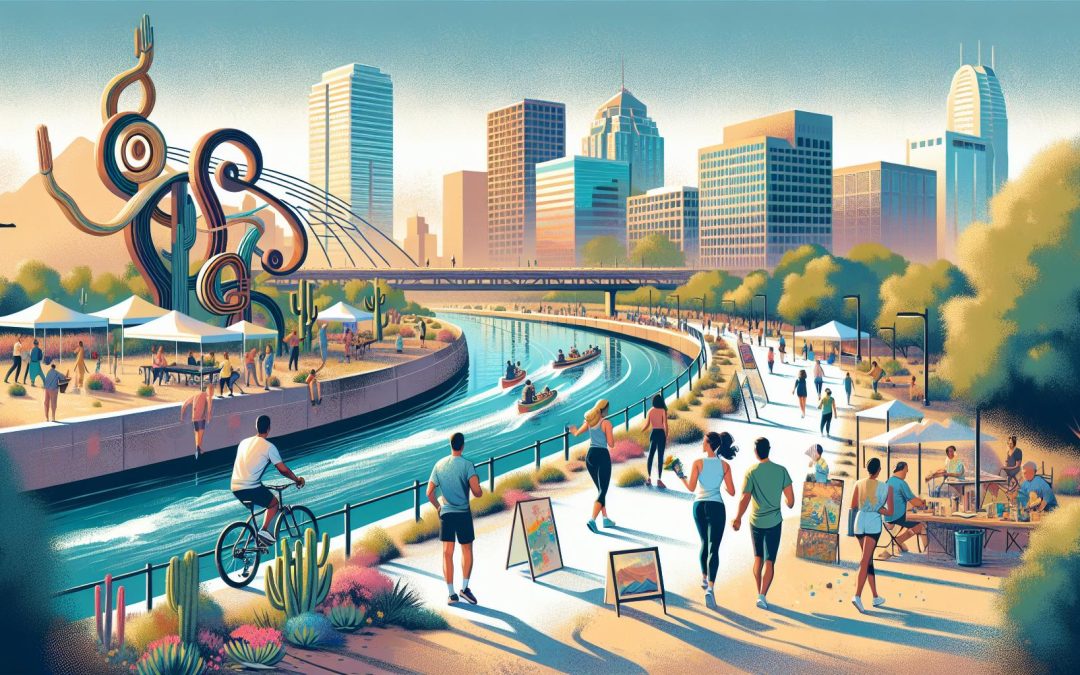I’ve always been fascinated by the stories waterways tell, and the Arizona Canal is no exception. Winding its way through Scottsdale, this historic canal isn’t just a waterway; it’s a vibrant thread in the fabric of the city’s history and culture. Built in the late 19th century, it’s been a lifeline for the region, but there’s so much more to its story than irrigation and water supply.
Walking along its banks, I’ve encountered countless locals and visitors alike, each drawn by the canal’s serene beauty and the lively atmosphere of the surrounding areas. It’s a place where history and modernity blend seamlessly, offering a unique glimpse into the heart of Scottsdale. Whether it’s the art installations, the bustling eateries, or the tranquil waters themselves, the Arizona Canal holds a special place in the community’s heart.
History of the Arizona Canal
As I delve into the story of the Arizona Canal, I’m immediately struck by its rich and intricate past. Constructed in the late 19th century, this engineering marvel was part of a broader initiative to harness the Salt River’s waters for the burgeoning agricultural needs of Central Arizona’s desert landscape. It’s fascinating to imagine the sheer determination and hard work that went into the creation of the canal, especially during a time when modern machinery was not available.
The Arizona Canal, completed in 1885, was primarily developed by the Arizona Canal Company. This venture was backed by investors who saw the vast potential in irrigating the arid lands of the Phoenix Valley. The canal spans an impressive 44 miles, making it one of the largest built by any private company during that era. The engineering feats achieved here laid the groundwork for the development and growth of Scottsdale and the surrounding areas.
Over the years, the canal has evolved from a simple irrigation canal to a vital component of the region’s identity. In the early 20th century, it played a central role in transforming Scottsdale from a desert outpost to a flourishing agricultural community. The waters of the Arizona Canal paved the way for the cultivation of diverse crops, significantly boosting the local economy and instigating rapid growth.
As decades passed, the canal continued to foster a unique blend of history and modernity, symbolizing Scottsdale’s dynamic evolution. The adaptation of the canal to meet recreational and cultural needs alongside its original irrigation purposes showcases the innovative spirit that defines the region. Walking along the canal today, I’m amazed at how it bridges the past and present, serving as a living testimony to Scottsdale’s storied history and its ever-evolving landscape.
Impact on Scottsdale’s Development

When I think about the remarkable transformation of Scottsdale, it’s clear that the Arizona Canal wasn’t just a source of water; it was the backbone of the city’s development. Its construction in the late 19th century marked the beginning of a new era. Initially, its purpose was straightforward—to irrigate arid lands and boost agriculture. However, its impact stretched far beyond that, fostering growth in every corner of Scottsdale.
The arrival of water turned the once barren landscape into fertile farmland, attracting settlers and investors. They saw potential in the land, and before long, Scottsdale began morphing into a bustling agricultural community. The effect of the Arizona Canal on the city’s agronomy was profound. It wasn’t just about the crops; it was about turning a desert town into a land of opportunity.
Moreover, as Scottsdale evolved, so did the canal’s role. It became a catalyst for urban development. Residential areas, businesses, and industries flourished alongside its banks. The waterway encouraged not just agricultural, but economic diversity. Scottsdale’s growth trajectory was remarkable, and the Arizona Canal played a significant part in that.
Interestingly, the canal’s influence extends to the social and cultural fabric of Scottsdale. It has become a focal point for community activities, recreation, and aesthetic appreciation. The pathways along its banks host walkers, cyclists, and nature enthusiasts, showcasing how historical infrastructure can blend with modern living. The canal’s transformation from a functional irrigation system to a vibrant part of Scottsdale’s lifestyle illustrates the city’s innovative spirit.
The Arizona Canal’s contribution to Scottsdale is multifaceted. Beyond its initial function of irrigation, it has been a pivotal element in shaping the city’s economy, community, and identity.
Recreational Activities along the Canal
Walking along the Arizona Canal, it’s hard not to be captivated by the blend of natural beauty and community vibrancy. The canal isn’t just a waterway; it’s a lifeline for recreation in Scottsdale. With its extensive paths, the canal offers an urban oasis for joggers, cyclists, and walkers like me who appreciate the scenic views and the gentle hum of city life.
One of the most delightful aspects of the canal is its accessibility. The pathways are well-maintained, making them ideal for an afternoon bike ride or a leisurely stroll. I often find myself sharing the path with families, fitness enthusiasts, and people simply looking to unwind amidst nature.
Art installations and cultural exhibits pepper the canal banks, transforming ordinary walks into immersive artistic experiences. These installations aren’t just for show; they tell the stories of Scottsdale’s rich history and diverse culture, illustrating how the community has evolved alongside the canal.
Waterfront Dining and Shopping
The canal also serves as a unique backdrop for several waterfront restaurants and boutiques. Dining al fresco while overlooking the water is one of my favorite ways to enjoy the local cuisine. The gentle ripple of the water, combined with the warm Arizona sun, creates a dining experience that’s hard to beat.
Moreover, festivals and events frequently light up the canal area, infusing it with energy and excitement. From art walks to live music performances, the canal is at the heart of Scottsdale’s social scene. It’s incredible to see how this historic waterway has transformed into a bustling hub of activity, fostering a sense of community and engagement among residents and visitors alike.
In essence, the Arizona Canal is more than just an engineering feat; it’s a vibrant part of Scottsdale that offers endless opportunities for recreation, leisure, and cultural exploration. Whether you’re a local or a tourist, there’s something truly special about spending time along the canal.
Art Installations and Cultural Significance
The Arizona Canal isn’t just a picturesque backdrop for outdoor activities; it’s a canvas that captures the cultural heartbeat of Scottsdale. As I walk along the canal, it’s fascinating to see how art installations become vibrant storytellers, narrating tales from the region’s past. These pieces do more than decorate the area; they breathe life into Scottsdale’s history, making every stroll a learning experience.
One standout feature is the public art displayed along the canal’s banks. It’s a testament to the city’s commitment to blend urban development with cultural enrichment. The installations vary from sculptures that hint at the Native American heritage to modern pieces reflecting contemporary themes. Each artwork has a story to tell, enhancing my understanding of the area’s rich cultural tapestry.
Moreover, these art pieces serve as landmarks and meet-up points, fostering a sense of community among locals and visitors alike. They’re not just objects to admire; they’re conversation starters, making the canal a hub for social interactions. This alignment of culture and community has transformed the canal into a staple of Scottsdale’s social fabric, illustrating just how deep its roots go into the cultural and historical ground of the region.
At certain times of the year, the canal’s art installations play host to various cultural events and festivals. These gatherings are a vibrant mix of music, art, and food, showcasing local talents and bringing people together in celebration of Scottsdale’s diverse heritage. It’s during these moments that I truly appreciate the canal’s role in enriching the city’s cultural landscape, turning an ordinary waterway into a corridor of creativity and community connection.
Preserving the Legacy of the Arizona Canal

As I’ve delved deeper into the story of the Arizona Canal, I’ve become more fascinated by the efforts to preserve its rich legacy. It’s not just a waterway; it’s a living museum, echoing the footsteps of those who walked its banks centuries ago. The commitment to conserving this historic landmark while maintaining its role in contemporary Scottsdale life is truly remarkable.
Conservation initiatives have taken various forms over the years, ensuring the canal remains a vibrant part of the city. These include:
- Restoration projects that breathe new life into the canal’s infrastructure, securing its functionality for future generations.
- Educational programs aimed at teaching locals and visitors alike about the canal’s historical significance and its impact on the development of Scottsdale.
- Community clean-ups that not only keep the canal and its surroundings pristine but also foster a sense of ownership and pride among community members.
Moreover, the city has implemented sustainable practices to safeguard the environmental health of the canal. Efforts to reduce water pollution and manage waste more effectively are at the forefront of Scottsdale’s environmental strategy. These actions underline the city’s dedication to preserving the natural beauty and integrity of the Arizona Canal.
Partnerships between the city, local businesses, and nonprofit organizations have proven crucial in these endeavors. Fundraising events and volunteer opportunities regularly draw support from the community, highlighting the collective commitment to the canal’s preservation. It’s a synergy that not only protects the waterway but also reiterates its importance as a cultural and historical treasure.
Engagement with the arts has also played a pivotal role in the canal’s preservation. Art installations and performances along the banks tell the story of Scottsdale and the canal in visually striking ways. These creative expressions serve as a bridge between the past and the present, making history accessible and engaging to a wide audience.
Conclusion
Exploring the Arizona Canal has been a journey through Scottsdale’s heart, where art, culture, and history converge along its banks. The canal is more than just a waterway; it’s a canvas that reflects the city’s vibrant spirit and a testament to the community’s dedication to preservation and celebration of its heritage. The collaborative efforts to maintain its beauty and significance ensure that the canal remains a cherished landmark for generations to come. As I’ve delved into the story of the canal, I’ve been reminded of the power of community and the importance of connecting with our local history and environment. It’s clear that the Arizona Canal is not just a part of Scottsdale’s landscape but a vital component of its cultural identity, inviting us all to explore, engage, and appreciate the rich tapestry that makes up this unique city.







